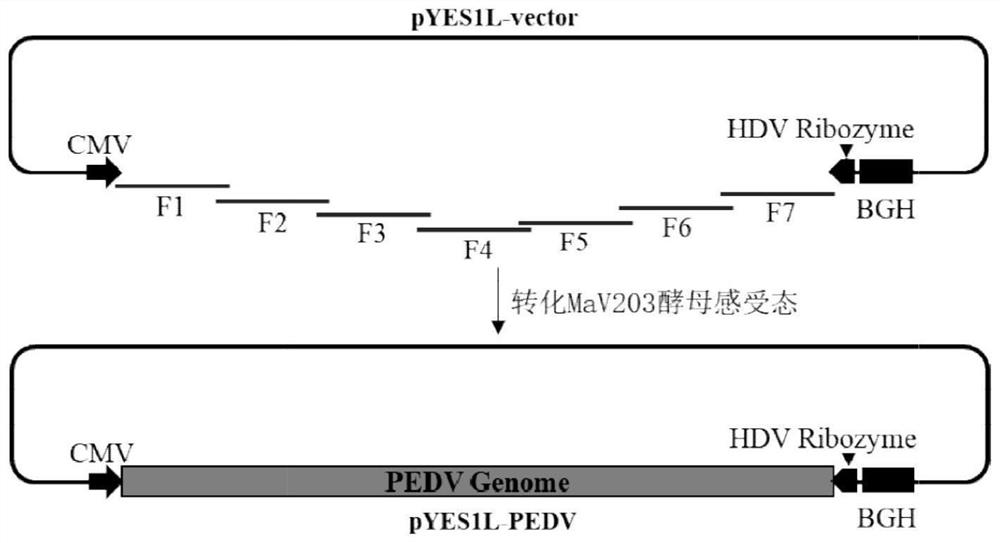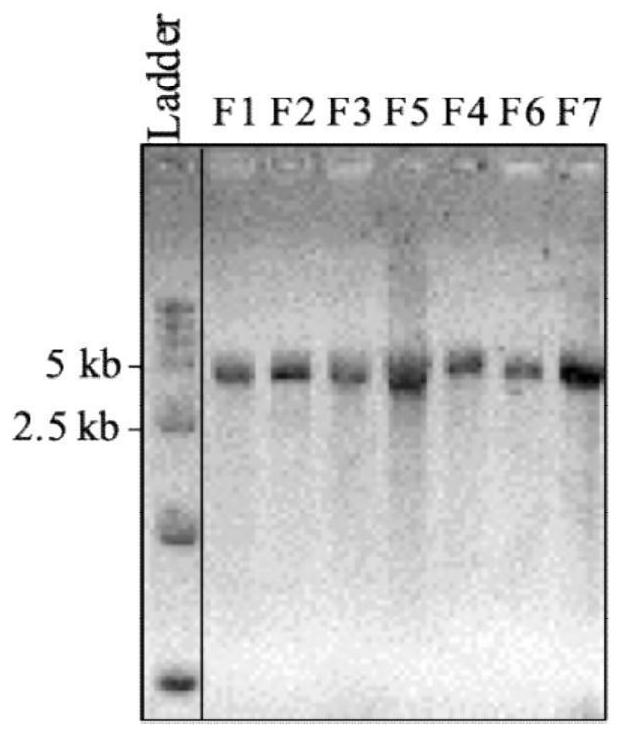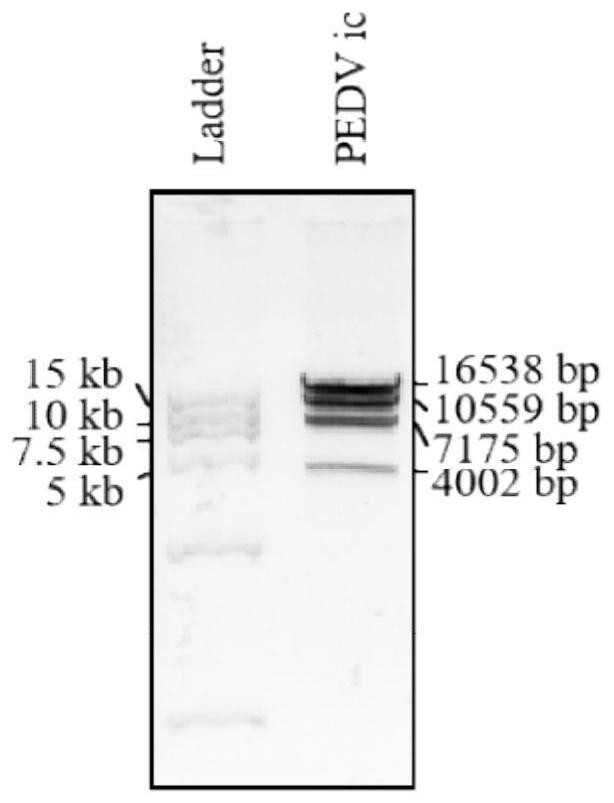Porcine epidemic diarrhea virus infectious cDNA clone and construction method and application thereof
A technology for porcine epidemic diarrhea and a construction method, which is applied in the field of construction of infectious cDNA clones of porcine epidemic diarrhea virus, can solve problems such as limited protection, achieve good stability, improve rescue efficiency, and improve efficiency.
- Summary
- Abstract
- Description
- Claims
- Application Information
AI Technical Summary
Problems solved by technology
Method used
Image
Examples
Embodiment 1
[0045] The construction of embodiment 1 porcine epidemic diarrhea virus HM strain infectious cDNA clone plasmid
[0046] Build strategies such as figure 1 shown. According to the full-length genome sequence of porcine epidemic diarrhea virus genotype II HM strain (Genbank accession number: MZ342899), 7 pairs of specific primers (see Table 1) were designed using Snapgene software to amplify F1, F2, F3, Seven fragments of F4, F5, F6 and F7.
[0047] The viral genome RNA of the PEDVHM strain was extracted according to the instructions of the viral genome DNA / RNA extraction kit (Tiangen Biochemical Technology Co., Ltd.). Using viral genome RNA as a template, according to IV First-Strand cDNA Synthesis Reaction (Thermo Fisher Scientific) describes the preparation of cDNA of HM strain of epidemic diarrhea virus. The reaction system is: 1 μL of 2 μM gene-specific reverse primer (PEDV-R7, PEDV-R4 or PEDV-R2), 1 μL of 10 μM dNTP Mix, and 11 μL of template RNA. The reaction proc...
Embodiment 2
[0053] Example 2 Construction of recombinant plasmid pYES1L-PEDV-EGFP based on CRISPR / Cas9 gene editing technology
[0054] Build strategies such as Figure 4 shown. Based on the CRISPR / Cas9 gene editing technology, two guide RNAs, PEDV-sgRNA1 and PEDV-sgRNA2 (synthesized in Nanjing GenScript Biotechnology Co., Ltd., see Table 1), were designed to cut the flanking sequences of ORF3 in pYES1L-PEDV to obtain Porcine epidemic diarrhea virus infectious cDNA cloning vector backbone lacking ORF3. The specific operation is: mix 5 μL of Cas9 Nuclease Buffer, 3 μL each of PEDV-sgRNA 1 (300 nM) and PEDV-sgRNA 2 (300 nM), and 3 μL of Cas9 Nuclease, add 3 μg of recombinant plasmid pYES1L-PEDV after 10 min at 37 °C, recover after 2 h at 37 °C Porcine epidemic diarrhea virus infectious cDNA cloning vector backbone lacking ORF3.
[0055] Using pEGFP-N1 (Clontech) as a template, PCR amplification was performed with primers EGFP-F and EGFP-R (see Table 1) to obtain the EGFP gene fragment. ...
Embodiment 3
[0057] Embodiment 3: Construction of helper plasmid
[0058]For the open reading frame region of the N gene in PEDV, use Snapgene software to design specific primers PEDV-N-F and PEDV-N-R (see Table 1), and use pYES1L-PEDV as a template to perform PCR amplification to obtain the N gene fragment. Insert the recovered and purified N gene fragment between the SacI and XhoI sites of the pCAGGS vector through conventional enzyme digestion ligation test, and then transform the ligation product into DH5α Escherichia coli competent cells, and screen out the correct recombinant plasmid pCAGGS- PEDV-N. Extract the plasmid according to the operating instructions of the endotoxin-free plasmid extraction kit, measure the concentration and store in -20°C.
[0059] Table 1 The primer sequences used in the present invention
[0060]
[0061]
PUM
 Login to View More
Login to View More Abstract
Description
Claims
Application Information
 Login to View More
Login to View More - R&D
- Intellectual Property
- Life Sciences
- Materials
- Tech Scout
- Unparalleled Data Quality
- Higher Quality Content
- 60% Fewer Hallucinations
Browse by: Latest US Patents, China's latest patents, Technical Efficacy Thesaurus, Application Domain, Technology Topic, Popular Technical Reports.
© 2025 PatSnap. All rights reserved.Legal|Privacy policy|Modern Slavery Act Transparency Statement|Sitemap|About US| Contact US: help@patsnap.com



